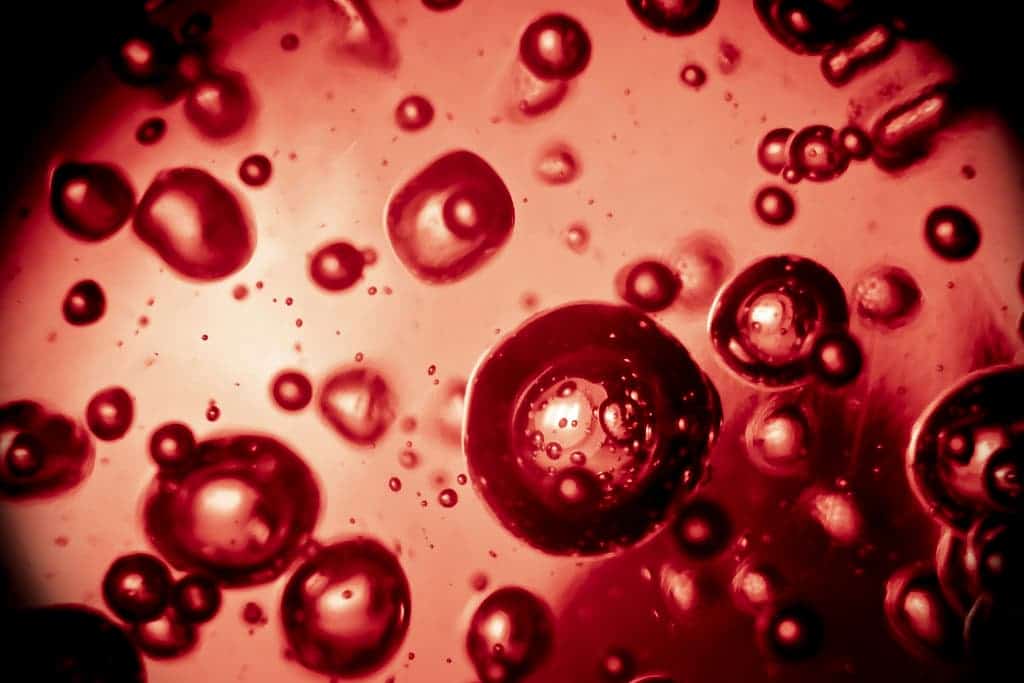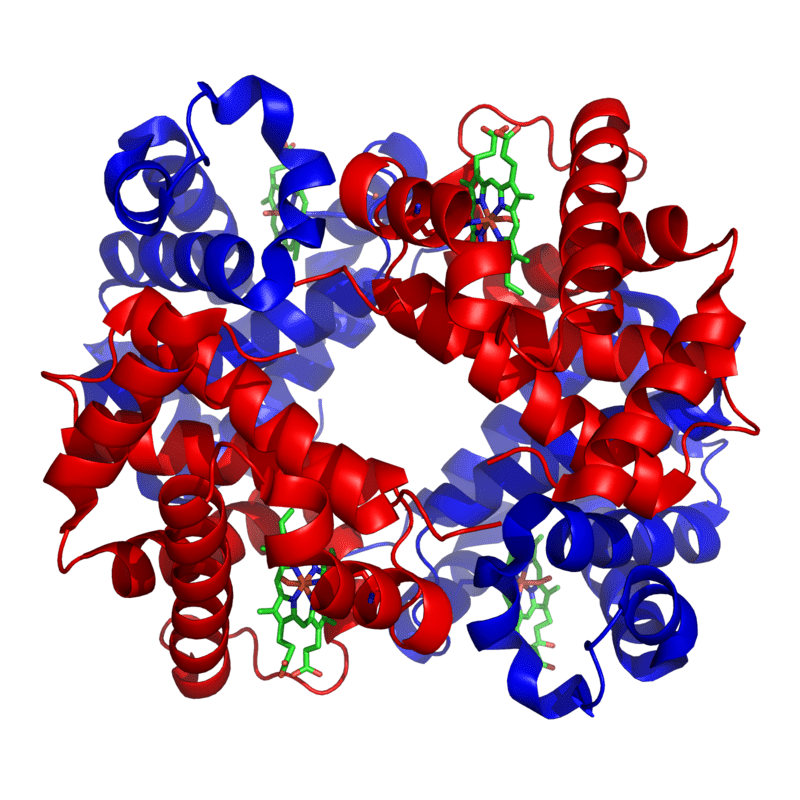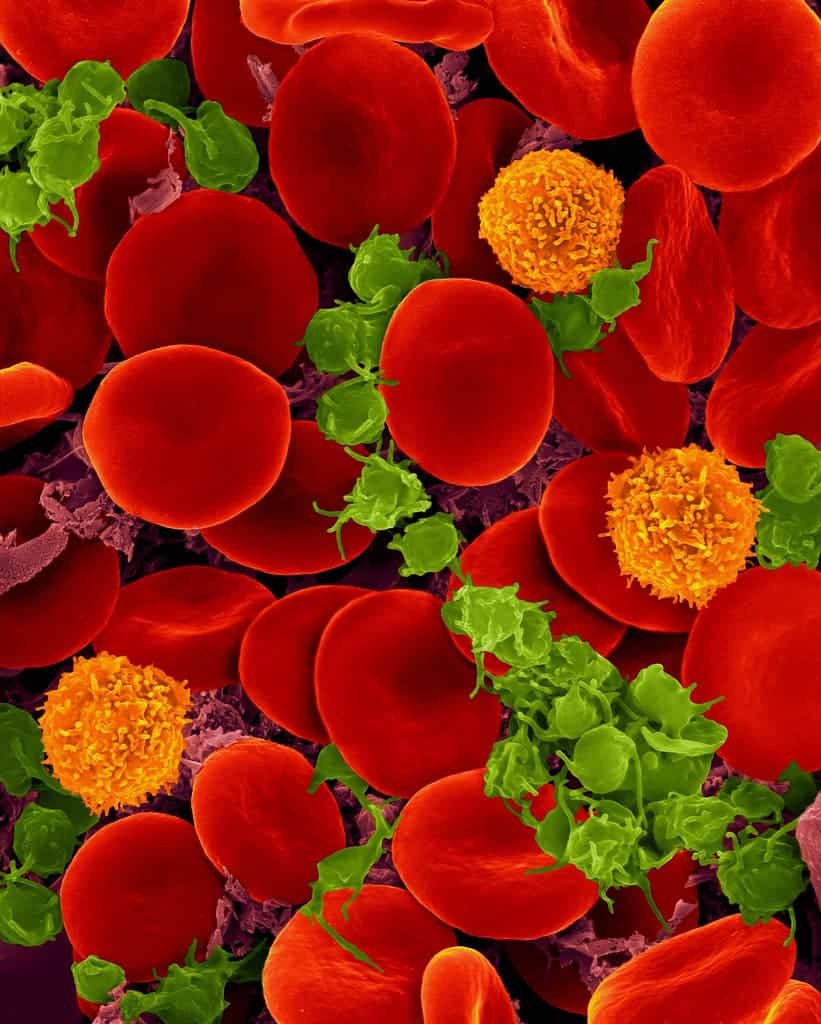If you like breathing and being alive, you should be very fond of hemoglobin. This iron-bearing compound is biology’s designated oxygen carrier.

With very few exceptions, blood is a distinctive, intense crimson. The color is given off by the high levels of hemoglobin (also spelled ‘haemoglobin’) in erythrocytes, red blood cells. Although that sounds like a fancy type of goblin, it’s actually a metalloprotein. And we should be very thankful that it’s there! Animals of our size would arguably not be possible without hemoglobin.
Important delivery
Your red blood cells are roughly 96% hemoglobin by dry weight, and around 35% when hydrated. This extremely high content should be our first indication of how critical the protein is for our organisms. So what exactly does it do? Well, in essence, it works as the body’s fuel supplier. Hemoglobin-laden cells make sure that there’s enough oxygen reaching tissues in your body for them to be able to generate energy (respiration).
Hemoglobin is the body’s designated oxygen carrier. Each molecule of it — at least, of the version the human body uses — can securely bind to four oxygen molecules and quickly let them go when needed. While blood can naturally carry some oxygen dissolved in its plasma, the hemoglobin in our red blood cells increases its ability to carry oxygen seventy-fold. Which is very good for us.
Although its main job is to carry oxygen to and fro, that’s not the only gas it can carry. Hemoglobin is also involved in scrubbing the ‘exhaust’ from cells, carrying around 25% of the CO2 produced by our cells, and shuttles nitric oxide (NO) around the body.
What exactly is it?
Like all other proteins, hemoglobin is a 3D structure created from multiple amino acids that are bound together, then folded around themselves. The term hemoglobin makes a direct nod to the molecule’s shape from the root Latin word ‘globus’ (meaning ball). While different lineages can employ heme/globin proteins (that’s the name of the wider family of these proteins) with different structures, the one humans and mammals use is made up of four sub-assemblies called ‘globular proteins’. The particular way these link up together is known as a globin fold pattern and is widely seen in the heme/globin family.

The thing that makes hemoglobin so important is an iron ion (atom) sitting in the middle of these four sub-sections. This is the specific area where O2 molecules reversibly bind to the protein, to be carried away. This iron atom is, in turn, welded to the protein through four covalent bonds with nitrogen atoms. Depending on the exact valence of this iron atom, either ferric or ferrous, the protein will be able to bind oxygen compounds. “Ferric” iron, or iron(II) can bind it, while ‘ferrous’ iron, iron(III), cannot. When not in use, this iron atom binds to a water molecule as a placeholder.
Carbon dioxide, on the other hand, binds to other areas of the heme proteins that make up the hemoglobin molecule.
What happens when it doesn’t work?
Hemoglobin’s reactivity and ability to bind to a long list of compounds is usually its key strength, but mostly because it can also easily unbind these molecules. One gas that throws a wrench in that approach is carbon monoxide: a colorless, odorless gas that’s very deadly.
The issue with this carbon monoxide (CO) is that once it binds to hemoglobin, it forms carboxyhemoglobin. This compound makes the bond between the cell and oxygen much more stable and, as such, harder to break down later on. For starters, this means that any red blood cell that has encountered a carbon monoxide molecule has its ability to transport oxygen dramatically (if not completely) reduced. Secondly, the reaction between these two produces a release of mitochondrial free radicals. These cause oxidative stress, which could be the main driver of aging, and also attract leucocytes (white blood cells) to the area.
A few of the effects of carbon monoxide poisoning, on a biological level, include damage to endothelial cells (the ones that membranes and blood vessels are made of), most notably damage to the vasculature of the brain, and lipid peroxidation (chemical cell damage) of brain membranes. Because carboxyhemoglobin is a very bright red, the skin of CO poisoning victims can take a pink or purple hue. It only takes ambient concentrations of around 0.1% to cause unconsciousness and possibly death.
Carbon monoxide is the product of an incomplete burn. It’s most commonly found in smoke from low-burning or smoldering fires. Any fire that doesn’t have access to as much oxygen as it ideally wants will produce some amount of CO. This carbon monoxide is also produced in cigarettes and is one of the main causes of feeling out of breath after a smoke. Up to 20% of all oxygen-binding sites can be blocked by CO in heavy smokers.

A bit ironically, the process through which hemoglobin is recycled in our spleen is the only natural source of carbon monoxide in the human body, and it accounts for the baseline levels of this gas found in our bloodstream. Each healthy red blood cell lives to around 120 days before being recycled.
Cyanide (CN-), sulfur monoxide (SO), sulfide (S2-), and hydrogen sulfide (H2S) groups also like binding to hemoglobin and not letting go, making them very toxic to us. Avoid breathing them in at all costs.
A too-low number of red blood cells — and thus, insufficient hemoglobin to carry gases around — is known as ‘anemia’. Anemia is the most common blood condition in the US, affecting around 6% of the population. In very broad terms, it is caused by either loss of blood, the inability to produce enough red blood cells, or conditions that lead to a rapid loss of such cells, although some cases are caused by genetics.
Women, older individuals, and those with long-lasting conditions are more likely to have anemia. Old age and chronic medical conditions can cause anemia by damaging the body’s ability to produce and recycle hemoglobin; women are more likely to develop iron-deficiency anemia due to the blood loss related to their menstrual cycle.
Symptoms of anemia include dizziness, or feeling like you’re about to pass out; headaches; unusual heartbeat patterns, shortness of breath, cold hands and feet, tiredness and physical weakness; pain in the chest, belly, bones, or joints, or swelling, can also be a symptom.
Any hemalternatives?
Oxygenated hemoglobin gives the blood in our arteries its scarlet color; unoxygenated blood flowing back to the heart and lungs is a darker color, although the veins that carry it often appear a bit more purple or blueish. A related compound known as myoglobin is why our muscles, or the muscles in red meat are shiny red but also a bit grey. Myoglobin works pretty much the same as hemoglobin with the difference that it’s not meant to carry oxygen around, but rather keep it stored for use. Structurally, myoglobin only has one binding site (it can hold less oxygen than hemoglobin) but the bond is much more stable.
But if you want to go full blue blood, you can go for hemocyanin. This is the second-most common molecule used to transport oxygen in blood after hemoglobin and is seen in many mollusks or anthropods. It substitutes iron heme groups for copper-bearing ones, and turns a very rich blue when oxygenated.
If you want to go for pink or violet, instead, try hemerythrin. It’s not a very commonly seen compound, with a handful of species, mainly marine vertebrates and a few worms (annelids), using it. It does stand out for turning clear when not oxygenated.
What annelids do like to use, however, are hemerythrin and erythrocruorin. They’re pretty similar in structure but with significantly different heme groups. Hemerythrin appears red when oxygenated and green when not. Erythrocruorin is common in earthworms and has the distinction of being a huge molecule, containing up to hundreds of heme-protein subsections and iron-ion binding sites.
Finally, a more exotic use of heme proteins is found in leguminous plants such as beans. They employ leghemoglobin to draw oxygen away from the nitrogen-fixing bacteria around their roots; oxygen here would impair the process of reducing nitrogen gas to nitrogen, which is a key nutrient for all plant-life and which imposes a ceiling on their ability to grow.


